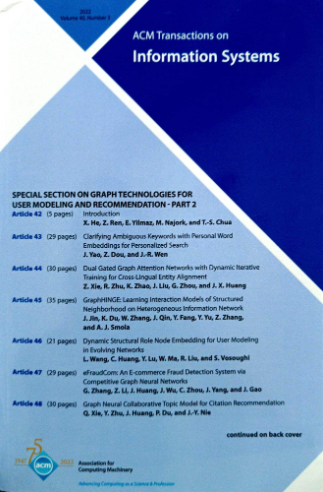通过结构信息论进行无监督社交机器人检测
IF 5.4
2区 计算机科学
Q1 COMPUTER SCIENCE, INFORMATION SYSTEMS
引用次数: 1
摘要
社交僵尸检测研究在维护信息传播秩序和可靠性、提高社交互动信任度方面发挥着至关重要的作用。目前主流的社交僵尸检测模型依赖于黑盒神经网络技术,如图神经网络、变形器等,缺乏可解释性。在这项工作中,我们提出了 UnDBot,这是一种新型的无监督、可解释、有效且实用的社交机器人检测框架。该框架建立在结构信息论的基础上。我们首先设计了三种社会关系度量标准,以捕捉社交机器人行为的各个方面:发帖类型分布、发帖影响力和关注者与关注者比率。我们利用这三种新关系构建了一个新的、统一的、加权的社交多关系图,旨在为社交用户行为的相关性建模,并发现用户之间的远距离相关性。其次,我们介绍了一种优化异构结构熵的新方法。这种方法涉及对社交多关系图中的边缘信息进行个性化聚合,生成二维编码树。异构结构熵有助于解码社交机器人网络的实质性结构,并实现社交机器人的分层聚类。第三,提出了一种新的社区标签方法,通过计算用户的固定分布、衡量用户对网络结构的贡献以及统计社区内用户聚集的强度来区分社交机器人社区。与十种具有代表性的社交僵尸检测方法相比,UnDBot 在四个真实社交网络数据集上的综合实验证明了其有效性和可解释性的优势。本文章由计算机程序翻译,如有差异,请以英文原文为准。
Unsupervised Social Bot Detection via Structural Information Theory
Research on social bot detection plays a crucial role in maintaining the order and reliability of information dissemination while increasing trust in social interactions. The current mainstream social bot detection models rely on black-box neural network technology, e.g., Graph Neural Network, Transformer, etc., which lacks interpretability. In this work, we present UnDBot, a novel unsupervised, interpretable, yet effective and practical framework for detecting social bots. This framework is built upon structural information theory. We begin by designing three social relationship metrics that capture various aspects of social bot behaviors:
Posting Type Distribution
,
Posting Influence
, and
Follow-to-follower Ratio
. Three new relationships are utilized to construct a new, unified, and weighted social multi-relational graph, aiming to model the relevance of social user behaviors and discover long-distance correlations between users. Second, we introduce a novel method for optimizing heterogeneous structural entropy. This method involves the personalized aggregation of edge information from the social multi-relational graph to generate a two-dimensional encoding tree. The heterogeneous structural entropy facilitates decoding of the substantial structure of the social bots network and enables hierarchical clustering of social bots. Thirdly, a new community labeling method is presented to distinguish social bot communities by computing the user’s stationary distribution, measuring user contributions to network structure, and counting the intensity of user aggregation within the community. Compared with ten representative social bot detection approaches, comprehensive experiments demonstrate the advantages of effectiveness and interpretability of UnDBot on four real social network datasets.
求助全文
通过发布文献求助,成功后即可免费获取论文全文。
去求助
来源期刊

ACM Transactions on Information Systems
工程技术-计算机:信息系统
CiteScore
9.40
自引率
14.30%
发文量
165
审稿时长
>12 weeks
期刊介绍:
The ACM Transactions on Information Systems (TOIS) publishes papers on information retrieval (such as search engines, recommender systems) that contain:
new principled information retrieval models or algorithms with sound empirical validation;
observational, experimental and/or theoretical studies yielding new insights into information retrieval or information seeking;
accounts of applications of existing information retrieval techniques that shed light on the strengths and weaknesses of the techniques;
formalization of new information retrieval or information seeking tasks and of methods for evaluating the performance on those tasks;
development of content (text, image, speech, video, etc) analysis methods to support information retrieval and information seeking;
development of computational models of user information preferences and interaction behaviors;
creation and analysis of evaluation methodologies for information retrieval and information seeking; or
surveys of existing work that propose a significant synthesis.
The information retrieval scope of ACM Transactions on Information Systems (TOIS) appeals to industry practitioners for its wealth of creative ideas, and to academic researchers for its descriptions of their colleagues'' work.
 求助内容:
求助内容: 应助结果提醒方式:
应助结果提醒方式:


